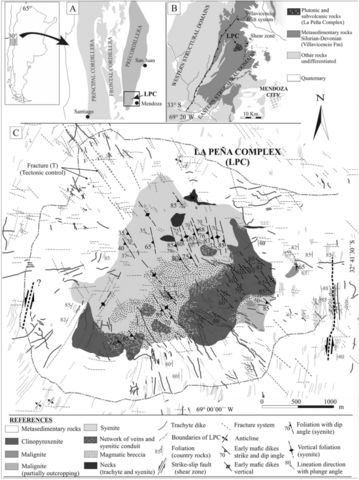stripes
The La Peña complex of Argentina is a K-saturated, subcircular intrusive complex 19 km2 in area with a 15 km diameter. It is emplaced into the clastic metasedimentary rocks of the eastern part of the Silurian-Devonian aged Villavicencio Formation of the Andean Precordillera. The main body of the complex is composed of syenite, foid-bearing syenite, foid syenite, and monzosyenite, with clinopyroxenite cumulates, restricted and discontinuously along the southern and eastern contact with the country rock. The clinopyroxenite predates the main syenite body as revealed by intrusive contacts. Later minor intrusives include dykes and volcanic necks of a range of trachytic and alkaline-mafic compositions. Some dykes bear nepheline and sodalite, replaced to varying degrees by zeolites. Malignite (melanocratic nepheline syenite) occurs as small bodies on the eastern margin of the complex. Detailed petrographic study and a model of emplacement is found in Pagano et al. (2014), whole rock geochemistry and radiogenic isotopic data can be found in Zappettini et al. (2013).
LUCASSEN, F., FRANZ, G., ROMER, R.L., SCHULTZ, F., DULSKI, P. & WEMMER, K., 2007. Pre-Cenozoic intra-plate magmatism along the Central Andes (17–34°S): composition of the mantle at an active margin. Lithos 99 pp 312-338. PAGANO, D.S., GALLISKI, M.A. & MÁRQUEZ-ZAVALÍA, M.F., 2014. Emplacement of the La Peña alkaline igneous complex, Mendoza, Argentina (33° S): Implications for the early Miocene tectonic regime in the retroarc of the Andes. Journal of South American Earth Sciences 50 pp 48-66. ZAPPETTINI, E.O., BASEI, M.A., VILLAR, L. & TEIXEIRA, W., 2005. Edad de la facies malingita del complejo alcalino Puesto de La Peña, Mendoza, Argentina. XVI Congreso Geológico Argentino, La Plata, Abstract Volume on CD, 6 p (abstr.). ZAPPETTINI, E.O., VILLAR, L.M., HERNÁNDEZ, L.B. & SANTOS, J.O. 2013 Geochemical and isotopic constraints on the petrogenesis of the Puesto La Peña undersaturated potassic complex, Mendoza province, Argentina: Geodynamic implications. Lithos 162-163 pp 301-316

